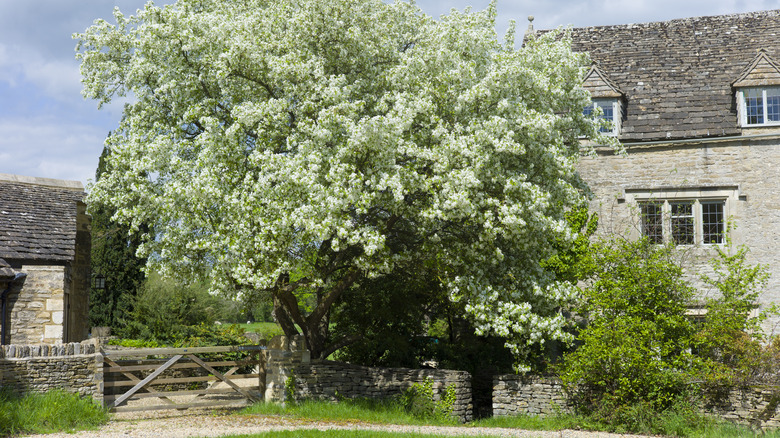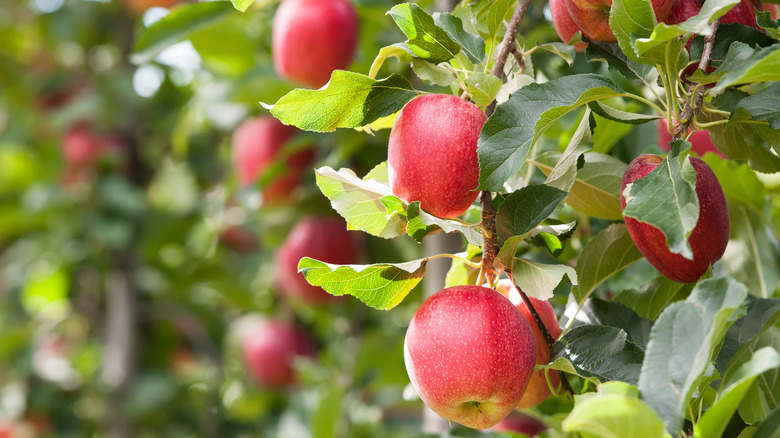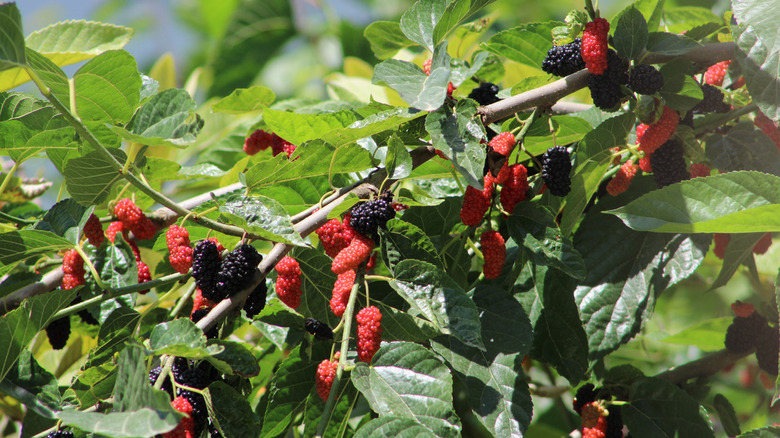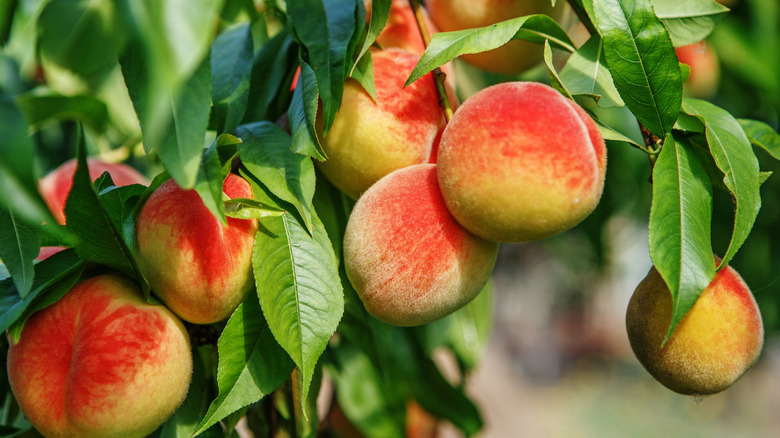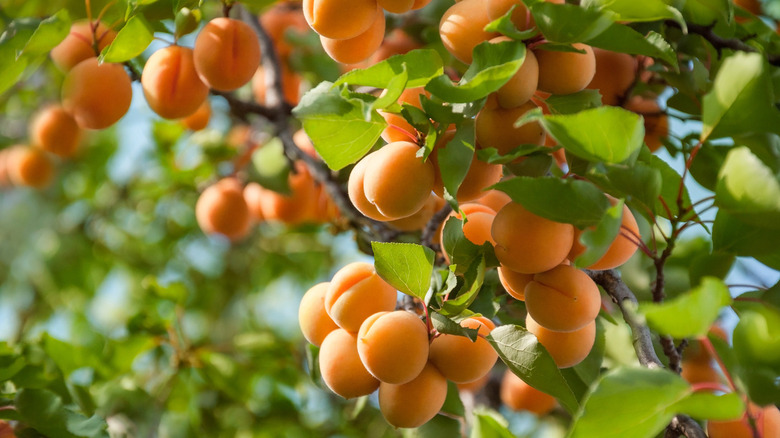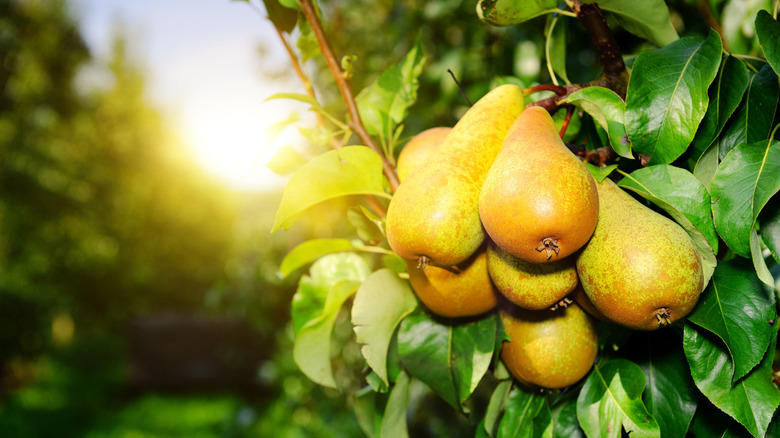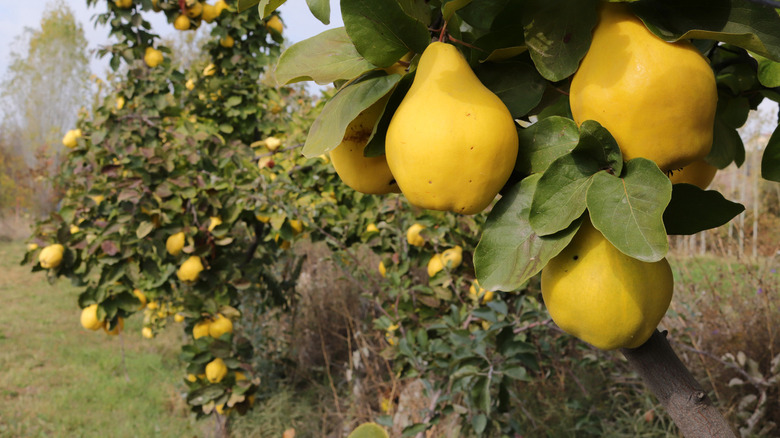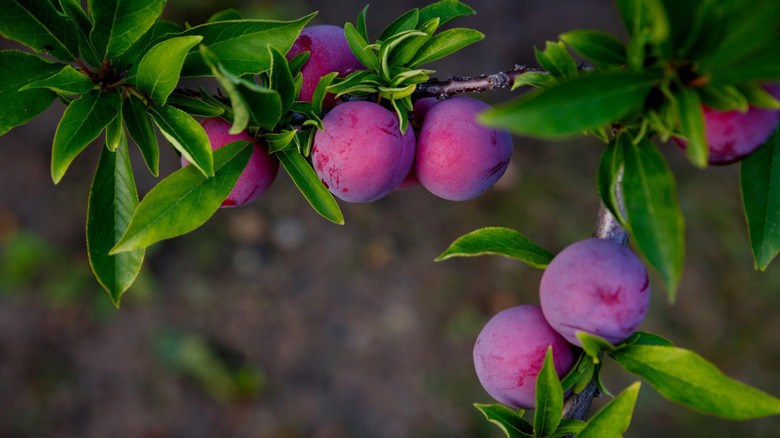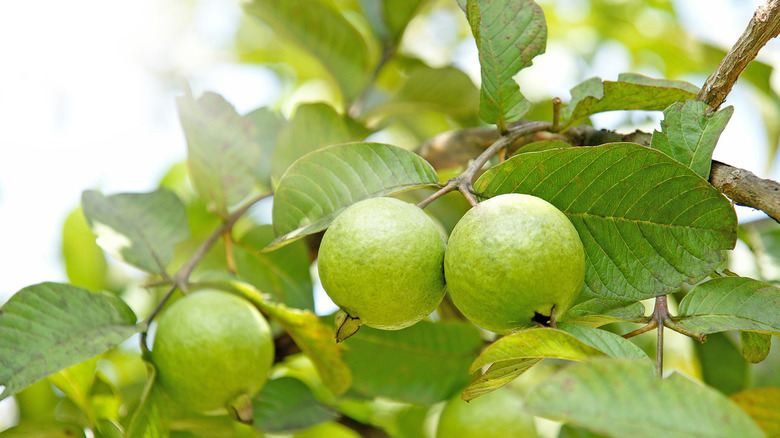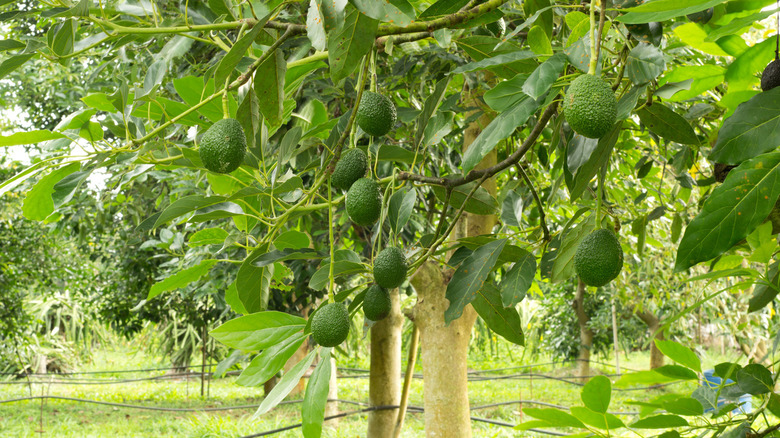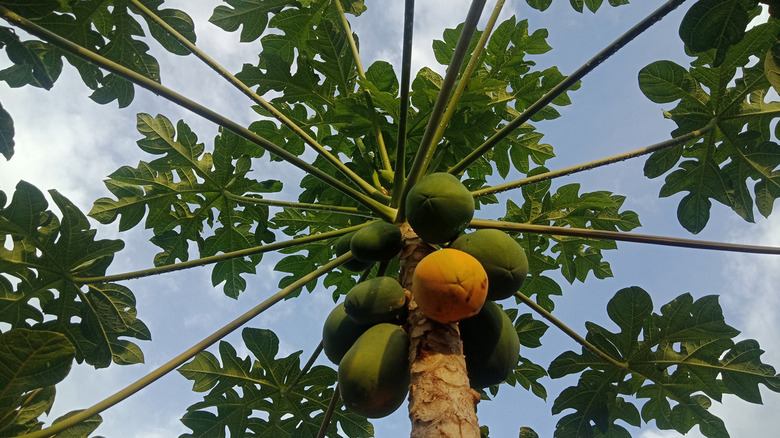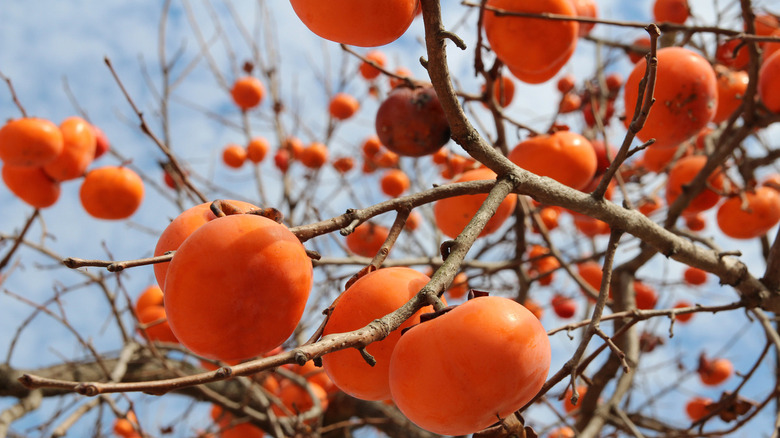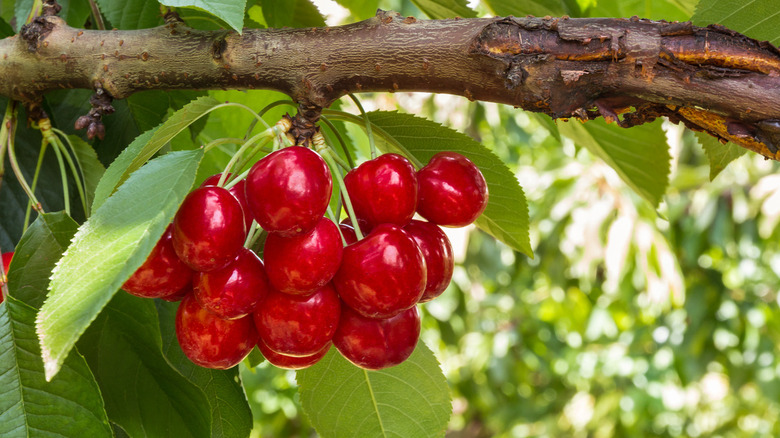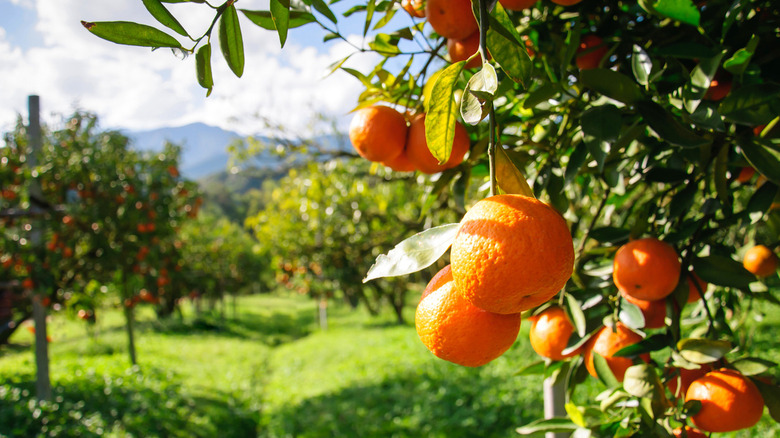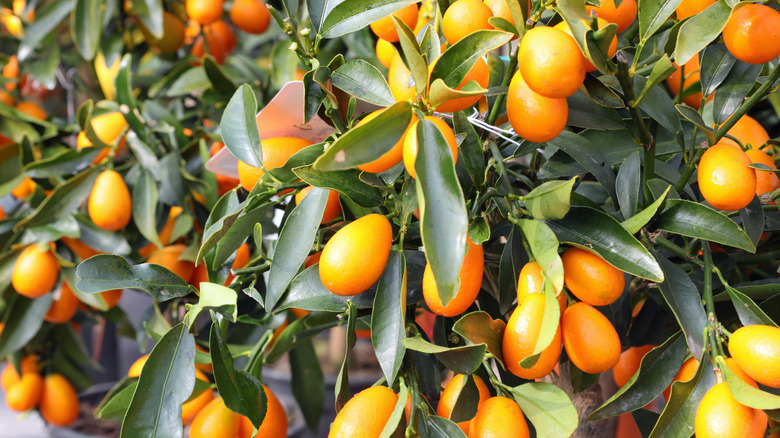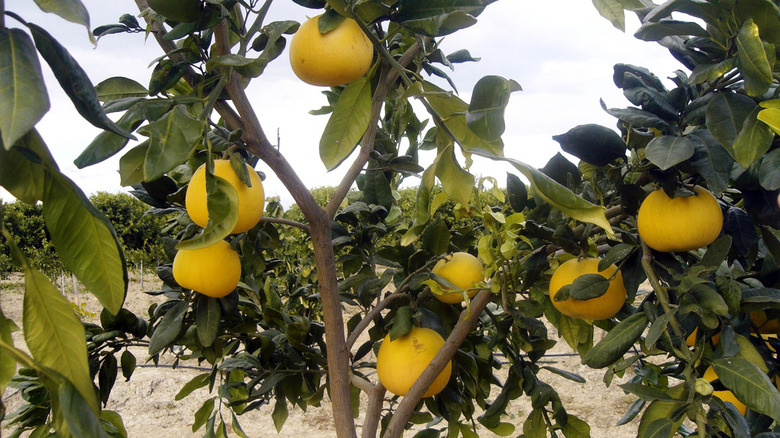15 Fruit Trees That Will Bring A Bountiful Harvest To Your Yard
While walking into a grocery store and picking the fruits of your choice is convenient, the satisfaction of growing your own fruit in the backyard is unmatched. Remember, this has nothing to do with the space you have in your yard.
Today, there are plenty of dwarf trees that can even grow in containers right on your balcony. To make it even better, you don't need to be a seasoned gardener to grow your own fruit. However, when selecting the types of fruit trees to incorporate in your yard, there are a couple of things that you need to keep in mind.
The first and most important consideration is the plant's USDA hardiness zone, according to Horticulture and Home Pest News from Iowa State University. The region's hardiness has a lot to do with flowering, which ultimately affects fruiting. When a plant fails to flower, then you shouldn't expect any fruit to harvest either.
It's worth mentioning that growing fruit trees requires patience; if you want to speed up the process of harvesting fruit from your own yard, then you'll have to spend more on an already established plant instead of growing and nurturing a tree from the seed. With this said, here are 15 fruit tree options that should help you get started.
1. Apple tree
The apple tree (Malus pumila) had to be the first on this list thanks to its versatility and ease of growth. There are several varieties of apple trees to choose from, be sure to get one that's suitable for your climatic conditions. Once established, apple trees are maintenance-free, all you need to do is the annual application of fertilizers and pruning (via the National Park Service).
Bloom Season: Spring
USDA Growing Zone: 3 to 8
Growing Conditions: Full sun
Soil Type: Moist well-drained soil
Size: 20 to 25 feet tall
2. Mulberry tree
The mulberry (Moras spp.) is a deciduous tree that is known for its tiny tasty fruits. These fruits are often not fresh in the grocery store, therefore it makes sense why you should grow them in your garden or yard. Mulberry is a good option for novice gardeners because it's native to North America, meaning fewer maintenance practices (per the University of Florida Gardening Solutions).
Bloom Season: Spring
USDA Growing Zone: 4 to 8
Growing Conditions: Full to partial sunlight
Soil Type: Moist-well drained soil
Size: 30 to 60 feet tall
3. Peachtree
The peach plant (Prunus persica) should be a must-have for anyone with a yard. While the fruit is tasty, the Environmental Work Group ranks commercial peaches among the fruits with the most pesticide residue. There are plenty of peach varieties, including dwarf options that can grow in containers. The PlantVillage mentions this fruit plant is also used for its ornamental value thanks to the bright pink flowers it produces.
Bloom Season: Spring
USDA Growing Zone: 5a-9a,
Growing Conditions: Full sun
Soil Type: acidic well-drained sandy soil
Size: Up to 6 feet for dwarf varieties and 25 feet for standard trees
4. Apricot tree
The apricot tree (Prunus armeniaca) is another great fruit tree addition to the garden — both for its fruit and its beauty. One thing to remember is that apricot trees are often quite sensitive to the cold and only bloom in warmer environments. As an ornamental plant, apricots will bless your garden or yard with beautiful blooms earlier than other plants, around mid-spring (via PlantVillage).
Bloom Season: Late April
USDA Growing Zone: 5 to 8
Growing Conditions: Full sun
Soil Type: Neutral well-drained soil.
Size: 20 to 30 feet tall
5. Pear tree
When it comes to the pear tree (Pyrus communis), there are essentially two varieties: European (pictured above) and Asian, per The Fruitguys. In the right conditions, the pear tree can grow quite tall; however, there are several dwarf varieties that are ideal for an outdoor garden or balcony space. The University of Minnesota Extension mentions you should plant two pear trees with compatible pollen for cross-pollination purposes.
Bloom Season: Spring
USDA Growing Zone: 4a-8a
Growing Conditions: Full sun
Soil Type: Neutral well-drained loamy soil
Size: 10 to 15 feet for dwarf varieties 40 to 50 feet for standard plants
6. Quince tree
The quince tree (Cydonia oblonga) is known for its ornamental qualities; however, did you know that you can relish the fruits as well? This particular tree is a rather small variety that's perfect for smaller outdoor gardens. As an ornamental plant, the quince tree blooms in white and pink flowers during the spring. They're easy maintenance and therefore, ideal for inexperienced gardeners (via Portland Nursery).
Bloom Season: Spring
USDA Growing Zone: 5 to 8
Growing Conditions: Full sun
Soil Type: Fertile with good drainage
Size: 12 to 15 feet tall
7. Plum tree
Prunus domestica, better known as the common plum, is a versatile slow-growing tree suited for most gardens. When buying a plum tree, ensure it's the fruiting type because some varieties only bloom and fail to fruit. According to the University of Minnesota Extension, since the plum tree blooms during spring, you need to be wary of temperature fluctuations. Also, consider the pest-resistant Methley variety.
Bloom Season: Spring
USDA Growing Zone: 5 to 9
Growing Conditions: Full sun
Soil Type: Acidic to neutral soil
Size: Up to 16 feet tall
8. Guava tree
The guava tree (Psidium guajava) is an exotic tree that loves warm climates. It's not common in North America as an outdoor plant but it can thrive well indoors (via Ask IFAS at the University of Florida Extension). The guava tree has short dwarf varieties that can be grown in pots; this allows you to take them outside and back indoors whenever necessary. They essentially thrive in most soils and require little maintenance.
Bloom Season: Spring
USDA Growing Zone: 9 to 11
Growing Conditions: Full sun
Soil Type: Rich-well drained soil
Size: 4 to 20 feet
9. Avocado tree
If you're a fan of guacamole, then having an avocado tree in your yard is a good idea. Typically, avocado trees are quite huge but there are smaller varieties that are suitable for smaller gardens. They're slow growers and you might need to buy established plants instead of growing from a seed. Since avocados are tropical fruits, the trees do well in warmer southern American regions (via the University of Florida Extension).
Bloom Season: Late winter to early summer.
USDA Growing Zone: 9 to 11
Growing Conditions: Full sun
Soil Type: Well-drained loamy soil
Size: Up to 60 feet tall
10. Pawpaw tree
A native U.S. tree, the pawpaw tree (Asimina triloba) grows large, edible fruit — the largest of any native tree in the United States. The fruit is loved because of its nutritional value as well as its possible medicinal properties (used in homeopathic remedies, via Verywell Fit), per the University of Kentucky College of Agriculture, Food and Environment. This tropical tree grows upright with moderate foliage characterized by elongated leaves.
Bloom Season: Spring
USDA Growing Zone: 5 to 8
Growing Conditions: Full sunlight
Soil Type: Moist well-drained soil
Size:15 to 25 feet
11. Persimmon tree
The persimmon tree (Diospyros virginiana) is another great addition to a functional garden. It produces a bright yellow fruit that's sour when unripe but has plenty of nutrition when consumed in time. The persimmon tree has two major varieties, according to the University of Florida Gardening Solutions: astringent and non-astringent. They are self-pollinating; therefore, you don't need several plants to get a fruit.
Bloom Season: Late Spring
USDA Growing Zone: 4 to 9
Growing Conditions: Full sun
Soil Type: Tolerant to all soil types
Size: 35 to 50 feet
12. Cherry tree
Make your outdoor garden functional by adding the cherry tree (Prunus avium). Although quite popular for its fruit, some homeowners choose to plant the cherry tree because of its ornamental value when it blooms during the spring. The Arbor Day Foundation notes the Bing type is the most common cherry variety in the U.S.
Bloom Season: Spring
USDA Growing Zone: 5 to 8
Growing Conditions: Full sun
Soil Type: Well drained fertile soil
Size: 12 to 35 feet
13. Mandarin orange tree
The mandarin orange (citrus reticulata) is a worthy garden plant because of its beautiful blooms and tasty fruit that also packs a ton of nutritional value. The mandarin orange tree is relatively hardier than the regular orange, allowing it to tolerate colder climates better. This tree loves warmer weather, and you might need to grow the dwarf variety indoors if you're in regions with harsher climatic conditions (via PlantVillage).
Bloom Season: March to April
USDA Growing Zone: 9 to 11
Growing Conditions: Full sun
Soil Type: Well drained fertile soil
Size: up to 25 feet
14. Kumquat tree
The kumquat tree (Citrus japonica) is a beautiful landscape tree that also produces edible fruits. The tree is naturally compact with deep green foliage typical of other citrus trees. Although the kumquat tree can adapt to containers, they particularly do well outside and in warmer climates. Per Rick's Tree Service, the kumquat tree matures slowly and takes up to five years to fruit.
Bloom Season: Spring to summer
USDA Growing Zone: 9 to 11
Growing Conditions: Full sun
Soil Type: Well drained loamy soil
Size: 7 to 10 feet
15. Grapefruit tree
Citrus × paradisi, or the grapefruit, is an evergreen tree that thrives in hot tropical climates. The grapefruit tree grows into thick foliage forming a canopy producing yellow fruits after blooming. Because it prefers warmer weather, you'll need to set up cold protection in your garden or yard for your grapefruit tree, especially if you hope to harvest its fruits (via PlantVillage).
Bloom Season: Between April and May
USDA Growing Zone: 9 to 11
Growing Conditions: Full sun
Soil Type: Well-drained loamy soil
Size: 33 to 50 feet
